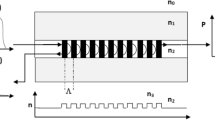Abstract
Radiation-mode coupling is stronger and more efficient in tilted fiber Bragg gratings than in other fiber gratings; it has good advantage in such fields as optical communication and optical sensors. A simplified coupled-mode theory (CMT) approach is proposed for what we believe to be the first time, whose validity is demonstrated by comparing its simulation results with that of the complete CMT equations. With the simplified CMT approach, a theoretical spectral analysis of coupling from core mode to counter-propagating radiation modes in reflective tilted fiber Bragg gratings is presented. The influence of grating length, refractive index modulation amplitude and tilt angle is exhaustively investigated on the transmission spectrum characteristics. The different dependences between s-polarized and p-polarized radiation-mode coupling on grating tilt angle are discussed, and the coupling strength of 45°-tilted gratings shows the greatest polarization dependence with the limitation of backward-propagating radiation-mode coupling.
Similar content being viewed by others
References
Feder K, Westbrook P, Ging J, et al. A compact, low resolution, wavelength monitor applied to raman pump power monitoring. In: IEEE Conference on Optical Fiber Communications, 2003, 1: 42–43
Riziotis C, Zervas M N. Design considerations in optical add/drop multiplexers based on grating-assisted null couplers. IEEE J Lightwave Tech, 2001, 19: 92–104
Chehura E, James S W, Tatam R P. Temperature and strain discrimination using a single tilted fibre Bragg grating. Opt Commun, 2007, 275: 344–347
Chan C, Chen C, Jafari A, et al. Optical fiber refractometer using narrowband cladding-mode resonance shifts. Appl Opt, 2007, 46: 1142–1149
Chen X, Zhou K, Zhang L, et al. Optical chemsensor based on etched tilted Bragg grating structures in multimode fiber. IEEE Photon Tech Lett, 2005, 17: 864–866
Zhao C, Yang X, Demokan M S, et al. Simultaneous temperature and refractive index measurements using a 3 degrees slanted multimode fiber Bragg grating. IEEE J Lightwave Tech, 2006, 24: 879–883
Caucheteur C, Mégret P. Demodulation technique for weakly tilted fiber Bragg grating refractometer. IEEE Photon Tech Lett, 2005, 17: 2703–2705
Chen X, Zhou K, Zhang L, et al. In-fiber twist sensor based on a fiber Bragg grating with 81° tilted structure. IEEE Photon Tech Lett, 2006, 18: 2596–2598
Kashyap R, Wyatt R, Campbell R J. Wideband gain flattened erbium fibre amplifier using a photosensitive fibre blazed grating. Electron Lett, 1993, 29: 154–156
Feder K S, Westbrook P S, Ging J, et al. In-fiber spectrometer using tilted fiber gratings. IEEE Photon Tech Lett, 2003, 15: 933–935
Westbrook P S, Strasser T A, Erdogan T. In-line polarimeter using blazed fiber gratings. IEEE Photon Tech Lett, 2000, 12: 1352–1354
Peupelmann J, Krause E, Bandemer A, et al. Fibre-polarimeter based on grating taps. Electron Lett, 2002, 38: 1248–1250
Zhou K, Simpson G, Chen X, et al. High extinction ratio in-fiber polarizers based on 45° tilted fiber Bragg gratings. Opt Lett, 2005, 30: 1285–1287
Mihailov S J, Walker R B, Stocki T J, et al. Fabrication of tilted fiber-grating polarization-dependent loss equalizer. Electron Lett, 2001, 37: 284–286
Erdogan T, Sipe J E. Tilted fiber phase gratings. J Opt Soc Am A, 1996, 13: 296–313
Li Y F, Froggatt M, Erdogan T. Volume current method for analysis of tilted fiber gratings. IEEE J Lightwave Tech, 2001, 19: 1580–1591
Walker R B, Mihailov S J, Grobnic D, et al. Shaping the radiation field of tilted fiber Bragg gratings. J Opt Soc Am B, 2005, 22: 962–975
Li Y, Wielandy S, Reyes P I, et al. Scattering from nonuniform tilted fiber gratings. Opt Lett, 2004, 29: 1330–1332
Erdogan T, Sipe J E. Radiation-mode coupling loss in tilted fiber phase gratings. Opt Lett, 1995, 20: 1838–1840
Parker R, Sterke CM. Reduced cladding mode losses in tilted gratings that are rotationally symmetric. IEEE J Lightwave Tech, 2000, 18: 2133–2138
Lee K S, Erdogan T. Fiber mode conversion with tilted gratings in an optical fiber. J Opt Soc Am A, 2001, 18: 1176–1185
Lee K S, Erdogan T. Fiber mode coupling in transmissive and reflective tilted Fiber gratings. Appl Opt, 2000, 39: 1394–1404
Author information
Authors and Affiliations
Corresponding author
Rights and permissions
About this article
Cite this article
Lu, S., Xu, O., Feng, S. et al. Analysis of coupling from core mode to counter-propagating radiation modes in tilted fiber Bragg gratings. Sci. China Inf. Sci. 53, 1078–1088 (2010). https://doi.org/10.1007/s11432-010-0093-x
Received:
Accepted:
Published:
Issue Date:
DOI: https://doi.org/10.1007/s11432-010-0093-x




